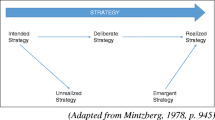Abstract
Since the 1980s, the New Zealand Police have attempted to introduce a number of extensive change management programmes to improve the efficiency and effectiveness of their core services: Project Blueprint, Policing 2000, Policing Excellence and Prevention First. The latest change management programmes ‘Policing Excellence and Prevention First’ arose from three circumstances that were placing pressure on the delivery of policing services: (1) the impact of the 2007 global financial crisis on public sector funding and budgets; (2) unsustainable increases in demand for police services and (3) the need for police to modernize, coupled with opportunities to lift productivity, for example through the better use of technology. The New Zealand Police’s operating environment had become increasingly complex in the decade prior to the 2007 global crisis. Crime, however, was declining, but the actual social cost of crime had been increasing. The New Zealand Government viewed the situation as unsustainable as the increasing costs were placing a heavy burden on the wider Justice Sector, with Justice Sector costs increasing 79% between 1999 and 2009. At the same time, there was an increasing demand for police services, which reflected the changes in social, demographic and economic conditions. In response to these pressures, the New Zealand Police identified a number of organizational improvement opportunities that could increase productivity and deliver efficient, sustainable services. These opportunities were developed and implemented under the two separate programmes called Policing Excellence and Prevention First. This chapter will describe and examine these programmes, and evaluate how successful they have been since their introduction in 2009–2010.
Access this chapter
Tax calculation will be finalised at checkout
Purchases are for personal use only
Similar content being viewed by others
Notes
- 1.
Although it was not explicitly defined in any of the available New Zealand Police documents relating to the development of Policing Excellence and Prevention First, the expression ‘prevention’ in the New Zealand Police context does not only include the prevention of crime related events but also other social ills that Police have become one of the responding agencies. For example, the police have extensive input into the design of policies and legislation relating to such issues as violence to women. In this way, the issue of prevention is not about preventing the offence from occurring but more about preventing the social environment that creates the situation for the offence to occur.
- 2.
In 2013, the New Zealand Police identified the five drivers of crime in New Zealand as families, youth. Alcohol, road policing, and organized crime and drugs (New Zealand Police, 2013b).
- 3.
Although Maori are only 14% of the New Zealand population, they account for more than 43% of criminal convictions, 47% of violent offending convictions and 51% of prison inmates (www.statistics.govt.nz).
- 4.
This a strategy relating to working with Maori to minimise Maori offending.
- 5.
An Iwi is a Maori community usually linked by family ties.
References
New Zealand Police. (n.d.). Tasking and coordination. Version 1.0. Unpublished. Wellington: New Zealand Police.
New Zealand Police. (2009). Fit for the future project: Executive summary for Police Association. Wellington: New Zealand Police.
New Zealand Police (2011a). Prevention first: National operating strategy 2011–2015. Retrieved May 20, 2012, from www.police.govt.nz.
New Zealand Police. (2011b). Prevention first: National tactical plan 2013–2014. Wellington: New Zealand Police.
New Zealand Police. (2011c). The New Zealand police deployment model: Right people, right place, right time, right result: Prevention first—National operating strategy 2011–2015. Wellington: New Zealand Police.
New Zealand Police. (2012). Policing excellence presentation. 9 November 2012. Unpublished, Police National Headquarters. Wellington: New Zealand Police.
New Zealand Police (2013a). District command centre operating model. Unpublished, prevention group, Police National Headquarters. Wellington: New Zealand Police.
New Zealand Police. (2013b). Drivers of crime: Progress, partnership and opportunities. Wellington: New Zealand Police.
New Zealand Police (2013c). Policing excellence: Implementation overview to 30 June 2013. Retrieved October 5, 2013, from http://www.police.govt.nz/sites/default/files/publications/policing-excellence-overview-to-30-june-2013.pdf.
New Zealand Police. (2013d). Prevention first: National tactical plan 2013–2014. Wellington: New Zealand Police.
New Zealand Police (2013e). Prevention first (tactical assessment). Unpublished, Police National Headquarters. Wellington: New Zealand Police.
New Zealand Police. (2013f). Neighbourhood policing team management manual. Wellington: New Zealand Police.
New Zealand Police. (2014). Policing excellence: The transformation of New Zealand police 2009–2014. Wellington: New Zealand Police.
Ratcliffe, J. (2004). Strategic thinking in criminal intelligence. Annandale, NSW: The Federation Press.
State Services Commission, The Treasury, & The Department of Prime Minister and Cabinet (2012). Performance improvement framework: Formal review of the New Zealand Police. Retrieved July 1, 2015, from www.police.govt.nz.
Author information
Authors and Affiliations
Corresponding author
Editor information
Editors and Affiliations
Appendix: The Tactical Plan Implementation Process
Appendix: The Tactical Plan Implementation Process

Adapted from New Zealand Police (2011b)
Rights and permissions
Copyright information
© 2021 The Author(s), under exclusive license to Springer Nature Switzerland AG
About this chapter
Cite this chapter
den Heyer, G. (2021). New Zealand Police’s Policing Excellence and Prevention First Strategy: A New Approach to Police Service Delivery. In: Albrecht, J.F., den Heyer, G. (eds) Enhancing Police Service Delivery. Springer, Cham. https://doi.org/10.1007/978-3-030-61452-2_13
Download citation
DOI: https://doi.org/10.1007/978-3-030-61452-2_13
Published:
Publisher Name: Springer, Cham
Print ISBN: 978-3-030-61293-1
Online ISBN: 978-3-030-61452-2
eBook Packages: Law and CriminologyLaw and Criminology (R0)



